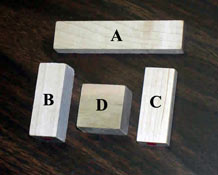How can centimeter cubes help us measure volume?
1. Think about measuring volume
Hang on to the investigation question: Do not refer to the investigation question until students have been introduced to the term cubic centimeter in Step 3; for now, stick with “How can we measure volume?”
Recall the work of the last session, when students thought about how much space objects take up. Draw attention to the volume line they created and pose a question:
- How could we actually measure the amount of space these objects take up?
- How can we measure their volume?
Have students brainstorm some answers. They may suggest measuring the height, or the weight, or filling the objects with water and then measuring the water in a measuring cup. Some of their ideas will be on the right track; others will not. As they grapple with the question, listen to what they say. Are they confusing weight and volume? Are they thinking three-dimensionally?
| How We Measure Things | |
|---|---|
| Height | Centimeters Inches |
| Weight | Grams Pounds |
| How much space (VOLUME) | ??? |
Begin to construct the table called “How We Measure Things.”
- When we want to measure the height of something, what units do we use?
- What about weight? Distance? Temperature?
Then fill in the last line of the table: “How much space (VOLUME),” leaving question marks in the units column. Let students know that by the end of the class, they will have an answer. But first they have a new challenge.
Volume formulas: Some students may know a formula for calculating volume. Acknowledge any algorithms that are offered, but let everyone know that the class will use a different method for measuring volume.

Show students the four wooden blocks, and tell them their task is to put them in volume order. Emphasize that they must work together, that they will have to investigate the blocks very carefully, and that they must come to agreement before recording the order in their notebooks.



